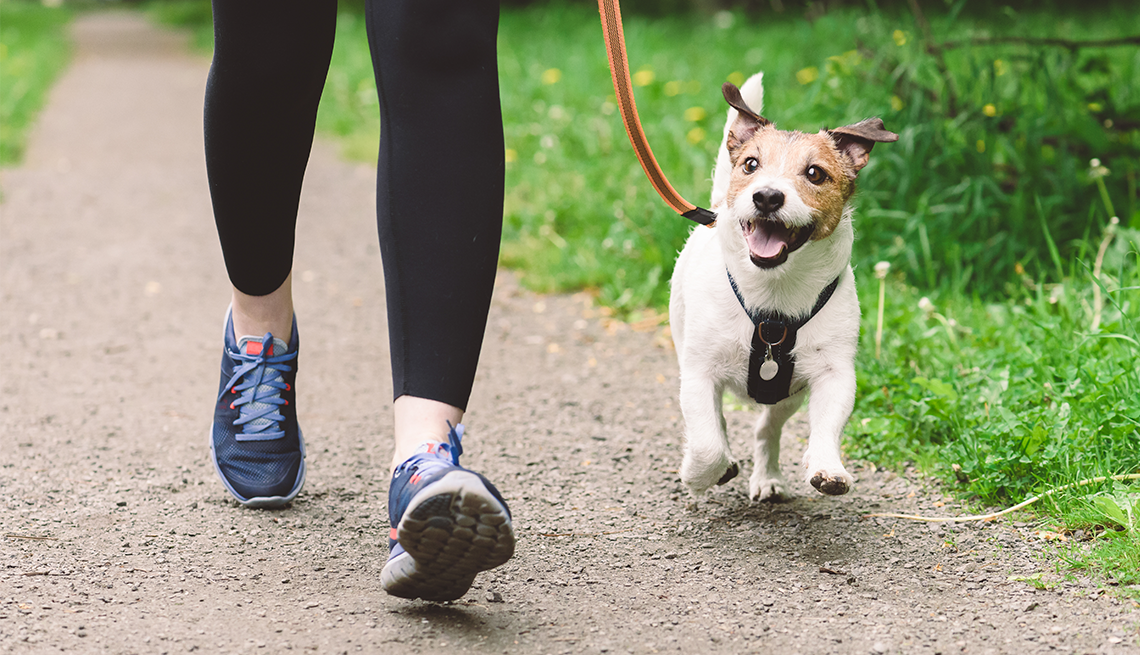
6 ways to prevent dog walking injuries
- Select a language for the TTS:
- UK English Female
- UK English Male
- US English Female
- US English Male
- Australian Female
- Australian Male
- Language selected: (auto detect) - EN
Play all audios:

Jerome Enad usually walks each of his three dogs — American Staffordshire terriers Sugar and Mr. Bones, and Froyo, a boxer mix — separately. One fateful day in 2022, however, he decided to
walk all three together while his wife was away. “Some days you have less energy than others, so I just wanted to get their walks out of the way,” says Enad, 57, of Pensacola, Florida.
“That was a bad decision.” That’s because Enad’s dogs have a nemesis: a neighbor dog whose presence sends them into a tizzy. Enad often anticipates potential confrontations and crosses
the street to avoid them. On this particular day, however, his dogs saw the animal antagonist first. “The three of them with their combined weight were too much. Once they all got
excited, it happened so fast,” says Enad, who tried to hold his ground as his dogs darted for their target. “My heels started skidding, and I landed on my butt and my back. Then they started
pulling me across the sidewalk until I was able to brace my foot against something — a tree, maybe, or a gutter. That’s when I wrenched my knee.” Enad’s experience isn't unusual. Dog
walking injuries are most common among adults ages 40–64 and are most serious among adults 65 and older, according to a recent study from Johns Hopkins University. Enad, who happens to be a
retired orthopedic surgeon, had sprained the medial collateral ligament in his right knee. Although he was limping for weeks, he recovered with rest. It could have been much worse. And
for many older adults — almost 4 in 10 of whom have a dog — it often is. BEWARE OF FALLS AND FRACTURES From 2001 to 2020, 422,659 adults sought treatment in U.S. emergency rooms for
injuries sustained while walking leashed dogs, according to the April study from researchers at Johns Hopkins University. Many more injured dog walkers probably sought treatment with primary
care doctors and specialists, according to Ridge Maxson, one of the study’s authors and a fourth-year medical student at Johns Hopkins University. Older adults’ most common injuries from
dog walking are traumatic brain injuries and hip fractures, the study notes. Compared with younger dog walkers, older people are three times more likely to experience a fall while walking a
leashed dog, more than twice as likely to sustain a fracture and 60 percent more likely to sustain a traumatic brain injury. “For older adults, the most common injuries we found are two
of the most debilitating and life-changing injuries that older adults can experience,” says Maxson, who blames age-related declines in balance, bone density, gait, muscle strength and
vision. Hip fractures in older adults can limit mobility and overall independence, he says, adding that 15 percent to 36 percent of older adults who experience a hip fracture die within a
year of their injury. “As for traumatic brain injury, it’s been linked in older adults to enduring cognitive and psychosocial impairments, and a history of traumatic brain injury in
addition to normal age-related brain changes may actually accelerate cognitive decline,” he says. TIPS FOR SAFER DOG WALKING The takeaway isn’t that older adults shouldn’t own dogs,
Maxson insists. Rather, it’s that they should take proactive steps to minimize the risk of injury if they do. For example:
